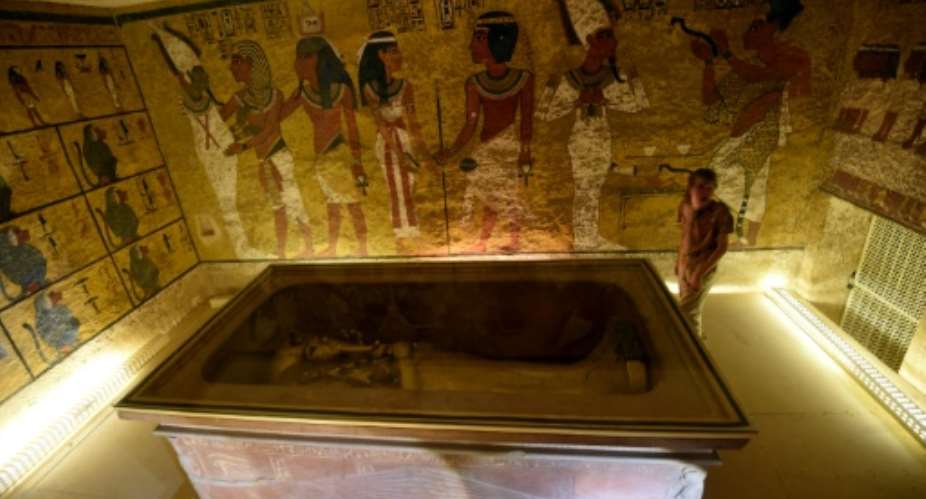Cairo (AFP) - The legendary treasure of ancient Egypt's boy king Tutankhamun, whose tomb British archaeologist Howard Carter discovered in the Valley of the Kings near Luxor in 1922, is shrouded in mystery.
A hoard uncovered intact
The tomb of Tutankhamun, who died aged 19 in 1324 BC after nine years on the throne, is pharaonic Egypt's only mausoleum found so far with its burial artefacts intact.
Many other resting places of pharaohs and dignitaries had been pillaged by tomb robbers down the centuries.
But in this case, a hoard of more than 4,500 objects laid out across five rooms included thrones, statues, furniture and weapons.
Among them are a gilded bed featuring posts made of carved lion heads, a chariot and a gold-handled dagger experts say was forged from the iron of meteorites.
The walls of the chamber in which Tutankhamun lay were covered in gold, and his coffin was a three-piece sarcophagus -- the innermost 110 kilos (240 pounds) of solid gold.
His funeral mask, now one of the world's most instantly recognisable Egyptian artefacts, was of gold inlaid with lapis lazuli, and with eyes of obsidian and quartz.
The mask was damaged in 2014 when its beard, symbol of the pharaohs, was stuck back on with epoxy glue after being knocked off during maintenance in the Cairo Museum.
It took a team of German experts two months of restoration work to fix the botched repair.
The 'curse' of King Tut
In November 1922, after six seasons of fruitless searching, Carter discovered the tomb with funding from Britain's Lord Carnarvon.
It took 10 years for Carter to complete his exploration of the tomb and catalogue the thousands of objects that he found.
Lord Carnarvon died in April 1923 in mysterious circumstances, fuelling speculation that the fabled "curse of the pharaohs" had struck one of those responsible for violating the tomb of "King Tut".
Carter himself died in 1939 without ever achieving the publication of his findings.
The death of Tutankhamun, which ended the 18th dynasty under the period of Egyptian history known as the New Kingdom, is itself an enigma.
It has been blamed variously on a chariot accident, malaria or Kohler's disease, which stops the flow of blood to the bones of the foot.
Some experts believe the resting place of the boy king contains two hidden rooms which may hold the tomb of legendary beauty queen Nefertiti, wife of Tutankhamun's father Akhenaton.





 Former Kotoko Player George Asare elected SRC President at PUG Law Faculty
Former Kotoko Player George Asare elected SRC President at PUG Law Faculty
 2024 elections: Consider ‘dumsor’ when casting your votes; NPP deserves less — P...
2024 elections: Consider ‘dumsor’ when casting your votes; NPP deserves less — P...
 You have no grounds to call Mahama incompetent; you’ve failed — Prof. Marfo blas...
You have no grounds to call Mahama incompetent; you’ve failed — Prof. Marfo blas...
 2024 elections: NPP creates better policies for people like us; we’ll vote for B...
2024 elections: NPP creates better policies for people like us; we’ll vote for B...
 Don’t exchange your life for wealth; a sparkle of fire can be your end — Gender ...
Don’t exchange your life for wealth; a sparkle of fire can be your end — Gender ...
 Ghana’s newly installed Poland train reportedly involved in accident while on a ...
Ghana’s newly installed Poland train reportedly involved in accident while on a ...
 Chieftaincy disputes: Government imposes 4pm to 7am curfew on Sampa township
Chieftaincy disputes: Government imposes 4pm to 7am curfew on Sampa township
 Franklin Cudjoe fumes at unaccountable wasteful executive living large at the ex...
Franklin Cudjoe fumes at unaccountable wasteful executive living large at the ex...
 I'll 'stoop too low' for votes; I'm never moved by your propaganda — Oquaye Jnr ...
I'll 'stoop too low' for votes; I'm never moved by your propaganda — Oquaye Jnr ...
 Kumasi Thermal Plant commissioning: I pray God opens the eyes of leaders who don...
Kumasi Thermal Plant commissioning: I pray God opens the eyes of leaders who don...
